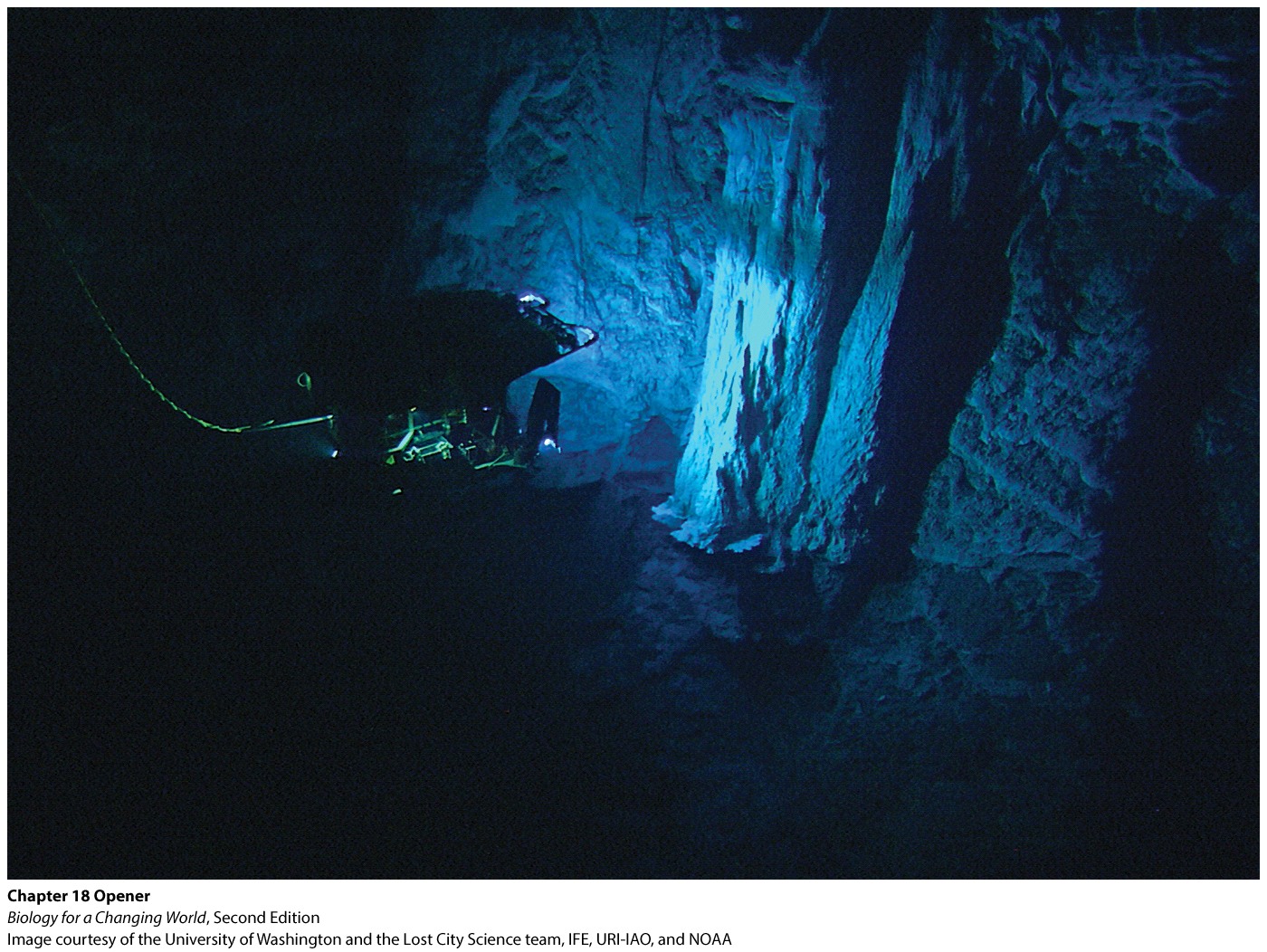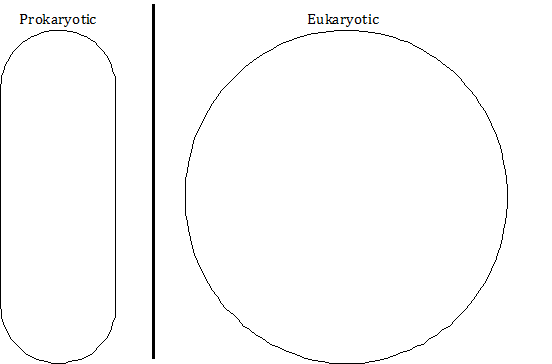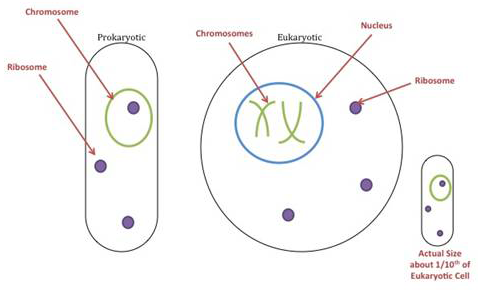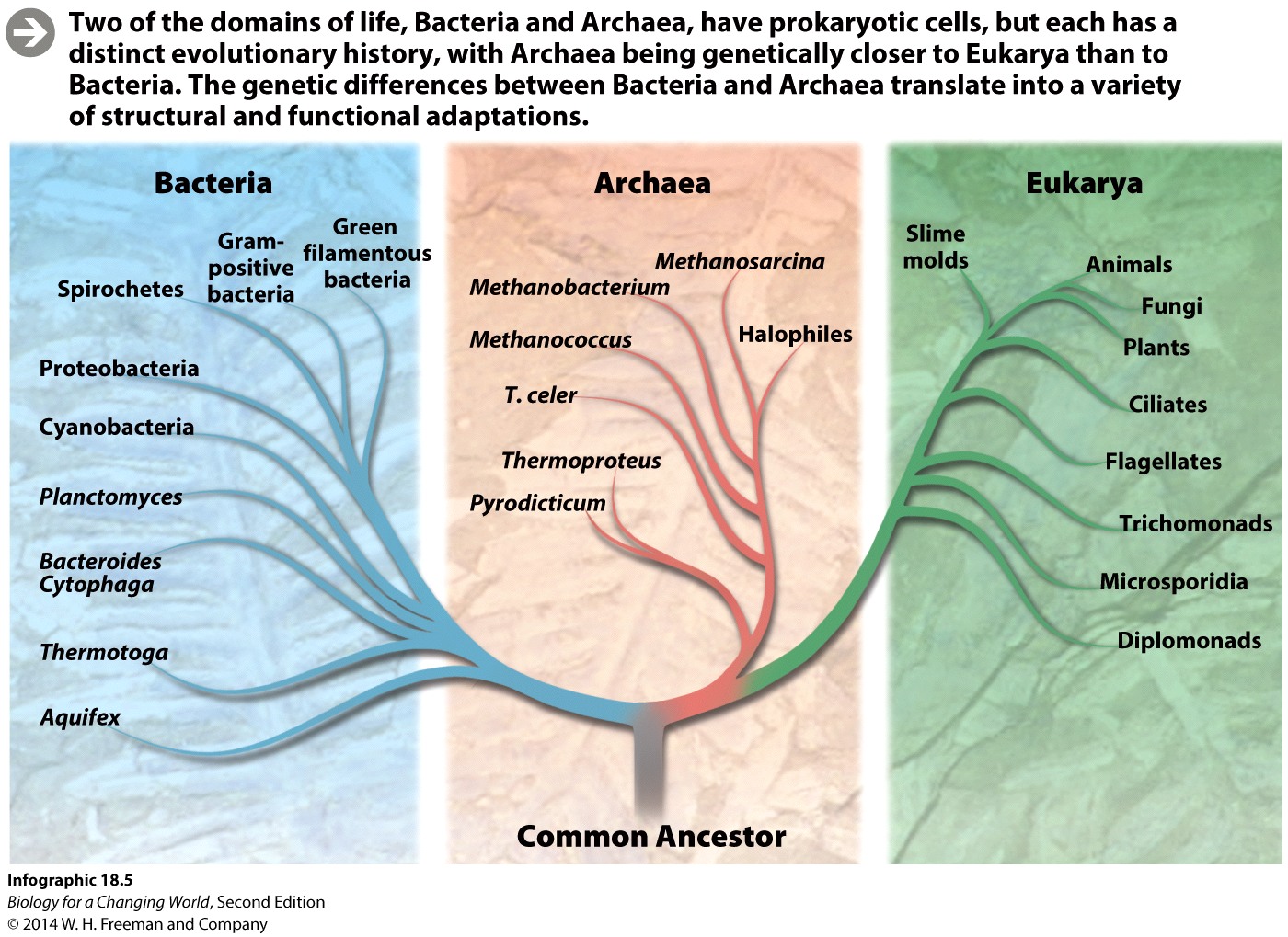
Chapter 1. Chapter 18: Prokaryotic Diversity
1.1 Introduction


Welcome to the Interactive Study Guide for Chapter 18: Prokaryotic Diversity! This Study Guide will help you master your understanding of the chapter's Driving Questions, using interactive Infographics and activities, as well as targeted assessment questions. Click "Next" to get started, or select a Driving Question from the drop-down menu to the right.
Lost City:
Probing life’s origins at the bottom of the sea
DRIVING QUESTIONS
- What are the prokaryotic domains of life?
- What are the features of bacteria and of archaea?
- What are the challenges faced by organisms living at Lost City, and how do they face them?
1.2 Driving Question 1:
Driving Question 1
What are the prokaryotic domains of life?
Why should you care?
Prokaryotic cells measure less than 1/10 the width of the finest human hair, so small that many of them could fit inside one of your cells. So, why care about something so small that it is difficult to find, even under a light microscope? Prokaryotic cells are the most numerous organisms on Earth by a wide margin; the many prokaryotic cells that live on you and inside you keep you healthy and provide many services to your body. Understanding how prokaryotic cells work is essential to knowing how your body works.
We humans have an innate need to categorize our world; it helps us make sense of it. Scientists who study prokaryotes have used several different techniques and lines of evidence to differentiate prokaryotes from eukaryotes. They have since divided the prokaryotes into Bacteria and Archaea. (The three groups: Eukaryotes, Bacteria, and Archaea, are called the three domains of life.) Understanding that there are two forms of prokaryotic life gives you greater insight into the organisms that drive life on Earth.
What should you know?
To fully answer this Driving Question, you should be able to:
- Compare and contrast the structure of prokaryotic and eukaryotic cells.
- Describe what conditions prokaryotes are adapted to based on the locations in which they grow and how those conditions influence the energy sources they use.
- Explain how the three domains of life—Bacteria, Archaea, and Eukarya—are related to one another.
Infographic Focus:
The infographics most pertinent to the Driving Question are 18.3, 18.4, and 18.5.
Test Your Vocabulary
Choose the correct term for each of the following definitions:
| Term | Definition |
|---|---|
| One of the two domains of prokaryotic life; the other is Bacteria. | |
| A usually unicellular organism whose cell lacks internal membrane-bound organelles and whose DNA is not contained within a nucleus. | |
| One of the two domains of prokaryotic life; the other is Archaea. |
Compare and contrast the structure of prokaryotic and eukaryotic cells.
1.
In your notebook, draw the two cells below and label the following features: chromosome(s), nucleus, ribosomes. (Don’t draw more than two chromosomes; make sure to draw them with the correct shape, i.e., linear or circular.) The cell diagrams below are not on the same scale. Then draw the outline of another prokaryotic cell near the eukaryotic one below to show their sizes relative to each other.


2.
Being large is typically a disadvantage to bacterial species. Why do you think bacteria remain small? (Hint: Think of how a eukaryotic cell takes in nutrients and compare that to a bacterium.)
Describe what conditions prokaryotes are adapted to based on the locations in which they grow and how those conditions influence the energy sources they use.
3.
Fill in the following table with the particular conditions prokaryotes have to face in each situation and the energy source(s) they might use in those situations.
| Location | Conditions | Energy Source(s) |
|---|---|---|
| Lost City |
Fill in: |
Fill in: |
| Inside intestines |
Fill in: none
|
Fill in: none
|
| In a salt lake |
Fill in: none
|
Fill in: none
|
| In a vein of coal under a mountain |
Fill in: none
|
Fill in: none
|
4.
Can you propose a connection between living conditions and energy sources?
Explain how the three domains of life—Bacteria, Archaea, and Eukarya—are related to each other.
5.

Using Infographic 18.5, are bacteria or archaea more closely related to the eukaryotes?
Explain how Carl Woese determined that there were two prokaryotic domains.
Many of the names of archeans and bacteria indicate where they live, what they produce, or what they use for food. For each archean or bacterial name below, related English words or combining forms (suffixes or prefixes) are listed. Look up the definition of those words or combining forms in a dictionary for extra insight about the organism.
| Organism Name | Related Words or Combining Forms | Meanings |
|---|---|---|
| Methanococcus | Methane |
Fill in: |
| Methanococcus | Coccus |
Fill in: |
| Cytophagus | Cyto- |
Fill in: |
| Cytophagus | -phagous |
Fill in: |
| Theroproteus | Thermic |
Fill in: |
| Theroproteus | Protean |
Fill in: |
| Organism Name | Related Words or Combining Forms | Meanings |
|---|---|---|
| Methanococcus | Methane | Methane using |
| Methanococcus | Coccus | Berry or round sphere-like shape |
| Cytophagus | Cyto- | Cell |
| Cytophagus | -phagous | Eater of |
| Theroproteus | Thermic | Heat |
| Theroproteus | Protean | Sea god who could change his form |
Review Questions
6.
The following are features of prokaryotic cells except
| A. |
| B. |
| C. |
| D. |
| E. |
7.
The three Domains of Life are
| A. |
| B. |
| C. |
| D. |
| E. |
8.
The one condition that no prokaryote can survive is
| A. |
| B. |
| C. |
| D. |
| E. |
1.3 Driving Question 2:
Driving Question 2
What are the features of bacteria and of archaea?
Why should you care?
Bacteria are incredibly diverse and are adapted to an enormous variety of lifestyles. Many people only know of the bacteria that are pathogens and cause disease, but there are many other types of bacteria. Many different kinds of bacteria, including some of the photosynthetic cyanobacteria, are able to convert nitrogen gas from the atmosphere to ammonia or nitrate in a process called nitrogen fixation. Since plants need nitrogen, but cannot use it directly from the atmosphere, nitrogen fixation is essential for plants, the basis of all ecosystems on land, to be able to grow. Knowing that bacteria are diverse will help you understand that most of them are beneficial.
Archaea represent a new frontier in biology and science in general. In the past few decades, they have gone from being largely ignored, overlooked, and misunderstood to becoming a highly studied group. Their importance to life on Earth is becoming increasingly apparent.
What should you know?
To fully answer this Driving Question, you should be able to:
- Describe the many adaptations that different bacteria have evolved to succeed in a variety of habitats.
- Explain how archaea have evolved to live in a variety of habitats that often have extreme conditions.
Infographic Focus:
The infographics most pertinent to the Driving Question are 18.4, 18.6, and 18.7.
Test Your Vocabulary
Choose the correct term for each of the following definitions:
| Term | Definition |
|---|---|
| A disease-causing agent, usually an organism. | |
| Short, hairlike appendages extending from the surface of some bacteria, used to adhere to surfaces. | |
| The conversion of atmospheric nitrogen into a form that plants can use for growth. | |
| Whiplike appendages extending from the surface of some bacteria, used in movement of the cell. | |
| A relationship in which two different organisms live together, often interdependently. | |
| A sticky coating surrounding some bacterial cells that adheres to surfaces. |
Describe the many adaptations that different bacteria have evolved to succeed in a variety of habitats.
9.
What are the different keys to bacterial success? Match each of the following descriptions to the adaptation:
| Process that allows the production of carbohydrates from carbon dioxide and water using sunlight | |
| Whip-like appendages used to propel the organism through a wet environment | |
| Process of coexisting with another organism | |
| The making of either alcohol or organic acids (which taste sour) from a food source | |
| An enclosing sheath of substances that are often sticky and allow the organism to adhere to a surface | |
| An organism that may cause a disease, either by producing a toxin or by another means | |
| A short, tube-like appendage that can be used for adhering to a surface |
10.
An effective antibiotic is one that targets only bacteria-specific features. Given the diversity of bacteria, do you think there is an antibiotic that would affect all species?
Explain how archaea have evolved to live in a variety of habitats that often have extreme conditions.
11.
For each type of extremophile archaea listed below, give a short description of where they live and the special adaptations they need to have:
| Archaea Group | Description |
|---|---|
| Halophiles |
Fill in: |
| Hyperthermophiles |
Fill in: |
| Methanogens |
Fill in: |
| Archaea Group | Description |
|---|---|
| Halophiles |
Salt-loving archaea. They live in places with high salt concentrations, like evaporated seawater ponds, or salt lakes. These archaea have to be very efficient in maintaining the concentration of water inside the cell. |
| Hyperthermophiles |
Heat-loving archaea. They live in places where high temperatures are common and persistent, like ocean vents and geysers. They would have to have a way to prevent the denaturing of proteins that typically occurs at temperature levels such as these. |
| Methanogens |
Can live in extreme habitats, like ocean vents. They convert inorganic carbon dioxide and hydrogen to a usable form for energy. In this process, they produce methane. They would need a metabolic process to convert the inorganic compounds to usable forms. |
12.
Are all archaea extremophiles? (Refer to the text if necessary.)
13.
Suffixes: The three examples of extremophile archaea in Infographic 18.7 have either "-ophile" or "-ogen" in their name. What do you think these suffixes mean? (You many need to refer to a dictionary.)
-ophile:
-ogen:
Review Questions
14.
Pili are used for:
| A. |
| B. |
| C. |
| D. |
15.
True or False: A bacterium living in an underwater cave is likely to use photosynthesis for energy production.
| A. |
| B. |
1.4 Driving Question 3:
Driving Question 3
What are the challenges faced by organisms living at Lost City, and how do they face them?
Why should you care?
Most evidence available suggests that life began in water; oxygen was scarce, but other compounds and elements, like methane or hydrogen, may have been more plentiful than today. Knowing about how prokaryotes live at Lost City may provide knowledge of how life began.
What should you know?
To fully answer this Driving Question, you should be able to:
- Describe the extreme conditions created by the hydrothermal vents of Lost City.
- Describe the abiotic processes and conditions at Lost City that allow life to exist.
- Explain how autotrophs at Lost City obtain energy without sunlight.
- Explain how heterotrophic archaea at Lost City can extract energy from food without oxygen.
- Connect abiotic processes and conditions at Lost City to the lives of the organisms there.
Infographic Focus:
The infographics most pertinent to the Driving Question are 18.1, 18.2, and 18.8.
Describe the extreme conditions created by the hydrothermal vents of Lost City.
16.
Name three extreme conditions at Lost City, and explain their cause.
1:
2:
3:
Describe the abiotic processes and conditions at Lost City that allow life to exist.
17.
What substance does the process of serpentinization produce? What ingredients does the process require?
18.
What ingredients are required for the abiotic synthesis of carbon molecules, especially methane?
Explain how autotrophs at Lost City obtain energy without sunlight.
19.
The autotrophs most of us are familiar with are photosynthetic organisms that use sunlight as an energy source when they produce food. What energy source do autotrophs that undergo methanogenesis use?
20.
What is the product of methanogenesis?
Explain how heterotrophic archaea at Lost City can extract energy from food without oxygen.
21.
Some anaerobic heterotrophic archaea at Lost City use methane for food. What gas do they release after the consumption of methane?
Review Questions
22.
Archaea that can use hydrogen and carbon dioxide to make methane could be best called:
| A. |
| B. |
| C. |
| D. |
| E. |
23.
Why are some archaea able to live in hydrothermal ocean floor vents?
| A. |
| B. |
| C. |
| D. |
24.
Thought Question: Why do scientists think that the Lost City could give us clues to life on other planets?
Activity results are being submitted...